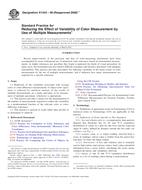Potrebujeme váš súhlas na využitie jednotlivých dát, aby sa vám okrem iného mohli ukazovať informácie týkajúce sa vašich záujmov. Súhlas udelíte kliknutím na tlačidlo „OK“.
ASTM E1345-98(2008)e1
Standard Practice for Reducing the Effect of Variability of Color Measurement by Use of Multiple Measurements (Includes all amendments And changes 11/28/2014).
Automaticky preložený názov:
Štandardná prax pre znižovanie účinku variability farieb Meranie pomocou niekoľkých meraní
NORMA vydaná dňa 1.6.2008
Informácie o norme:
Označenie normy: ASTM E1345-98(2008)e1
Poznámka: NEPLATNÁ
Dátum vydania normy: 1.6.2008
Kód tovaru: NS-41375
Počet strán: 5
Približná hmotnosť: 15 g (0.03 libier)
Krajina: Americká technická norma
Kategória: Technické normy ASTM
Anotácia textu normy ASTM E1345-98(2008)e1 :
Keywords:
color, color difference, color measurement, color tolerances, Color--paints/related coatings/materials, Instrumental measurement--color/light, Statistical methods--paints/related coatings, Tolerances--paints/related coatings/materials, Variability, Visual examination--color, ICS Number Code 17.180.20 (Colours and measurement of light)
Doplňujúce informácie
| Significance and Use | ||||||||||||||||
|
This practice should be used whenever measured color-scale or color-difference-scale values are to be compared to an established tolerance. In this way it can be demonstrated quantitatively that the sampling and measurement procedures are adequate to allow an unambiguous decision as to whether or not the mean results are within tolerance. This practice is based on portions of SAE Practice J 1545, as it applies to painted or plastic automotive parts. It is generally applicable to object colors in various materials. Textured materials, such as textiles, may require special consideration (see SAE Practice J 1545 and STP 15D Manual on Presentation of Data and Control Chart Analysis ). While Practice E 178 deals with outliers, it does not include definitions relating to the box and whisker technique. The definition of an outlier is operational and a little vague because there is still considerable disagreement about what constitutes an outlier. In any normally distributed population, there will be members that range from minus to plus infinity. Theoretically, one should include any member of the population in any sample based on estimates of the population parameters. Practically, including a member that is found far from the mean within a small sample, most members of which are found near the mean, will introduce a systematic bias into the estimate of the population parameters (mean, standard deviation, standard error). Such a bias is in direct contrast with the goal of this practice, namely, to reduce the effects of variability of measurement. For the purposes of this practice, no distinction is made between errors of sampling and members of the tails of the distribution. Practice E 178 has several methods and significance tables to attempt to differentiate between these two types of extreme values. |
||||||||||||||||
| 1. Scope | ||||||||||||||||
|
1.1 Reduction of the variability associated with average color or color-difference measurements of object-color specimens is achieved by statistical analysis of the results of multiple measurements on a single specimen, or by measurement of multiple specimens, whichever is appropriate. 1.2 This practice provides a means for the determination of the number of measurements required to reduce the variability to a predetermined fraction of the relevant color or color-difference tolerances. 1.3 This practice is general in scope rather than specific as to instrument or material. |
||||||||||||||||
| 2. Referenced Documents | ||||||||||||||||
|




 Cookies
Cookies
